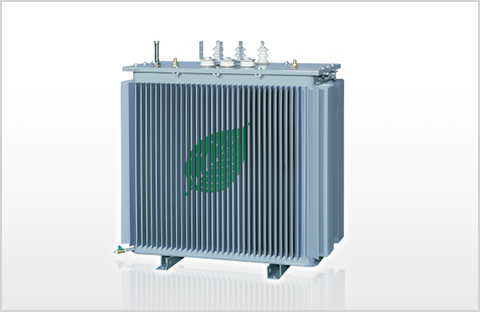High efficiency transformers reduce power consumption and CO2 emissions by 55%
First released February 2020
Released in 2018, the EX-α series is a super high efficiency oil-immersed transformer with an amorphous iron core. A pilot version of this product was adopted at Mitsubishi Electric’s Nagoya Works in the 2nd Factory Automation (FA) Development Center (E1 Building), which was established in 2017. Transformers with amorphous iron cores offer excellent efficiency, particularly by reducing no-load loss, making them an effective solution for lowering CO2 emissions and saving energy.
Key points of this case study
- 1. Minimizing loss during periods of low power consumption, as the E1 building does not operate at night
- 2. Emphasis on reliability with a view to 20 years of continuous operation
- 3. Significant reduction in CO2 emissions = lower running costs
Introduction to the Nagoya Works – E1 Building
Completed in July 2017, E1 at Mitsubishi Electric’s Nagoya Works is a modern facility designed to achieve high environmental performance and energy saving. With this philosophy in mind, the transformers to be installed at the site would need to be environmentally friendly too.
Ryohei Kitada of the Production System Promotion Department was responsible for selecting equipment for the E1 Building. This included the lighting, air conditioning, ventilation and elevators. When it came to the transformers, after careful consideration and comparison with other products, he proposed installing a super high efficiency device with an amorphous iron core which was under development by Mitsubishi Electric.
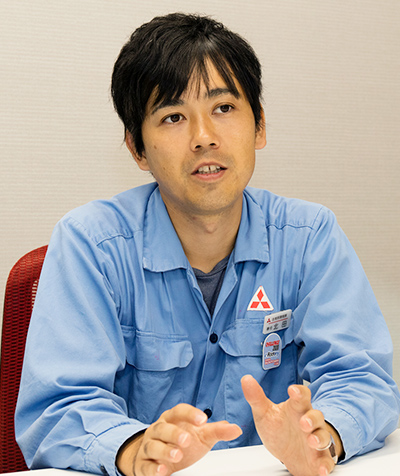
Ryohei Kitada, Production System Promotion Department, Nagoya Works
“The E1 Building does not operate at night, so I knew a transformer that could minimize standby power consumption would be the best choice. Transformers with amorphous iron cores can reduce no-load loss, offering high environmental performance and energy efficiency, so I realized this was the optimal solution,” says Kitada. His selection was influenced by the expected benefits of this new type of high-efficiency transformer. Hideyuki Koura of the Power Distribution Control Manufacturing Department was involved in the development of the transformer. When Kitada asked him for advice, “I thought that introducing the new transformers in the E1 Building would have a dual benefit,” he recalls. “A building that does not operate at night would showcase the properties of the amorphous iron core, and the development team could make use of the experience.”
The transformer helps to significantly reduce carbon dioxide (CO2) emissions and energy costs. It would be released as the EX-α in 2018, but the transformer installed in the E1 Building was a pilot version, which was still under development at the time.
Verifying environmental performance by adopting the transformer in-house
“Once a transformer starts operating, it basically continues to work without stopping. So, when you look at it over a span of several decades, its low carbon performance and energy efficiency really have an impact. We knew that introducing it in the environmentally focused E1 Building and verifying the reduction in power consumption and CO2 emissions would be effective for commercialization,” says Koura.
High efficiency transformers are expensive, so it is difficult for customers to commit to a product without a clear indication of its effectiveness. If the new transformer could be adopted in-house at the pilot stage, and demonstrate quantifiable environmental improvements, then these results would help to promote the product. As a result, this application would enable customers to adopt it with confidence, which was the thinking behind the project.
“In fact, Mitsubishi Electric's product range already included molded transformers with amorphous iron cores, but we didn’t have an oil-immersed transformer. So, customers were asking us to develop an oil-immersed transformer variant,” says Hideki Takeuchi of the Sales Department’s Transformer Section.
A total of ten amorphous transformers are installed on the roof of the E1 Building and have been in operation for over two years. So far, power consumption and CO2 emissions have been reduced by around 55% when compared to conventional transformers.
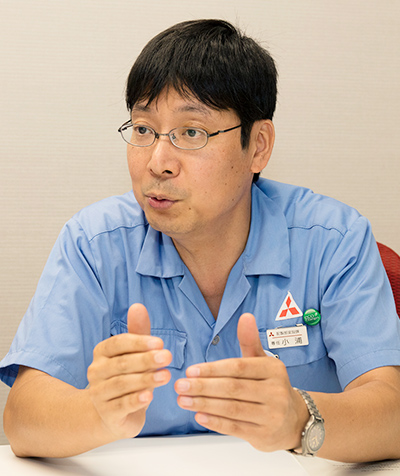
Hideyuki Koura, Transformer Design Section, Power Distribution Control Manufacturing Department, Nagoya Works
Highly regarded Mitsubishi Electric quality standards
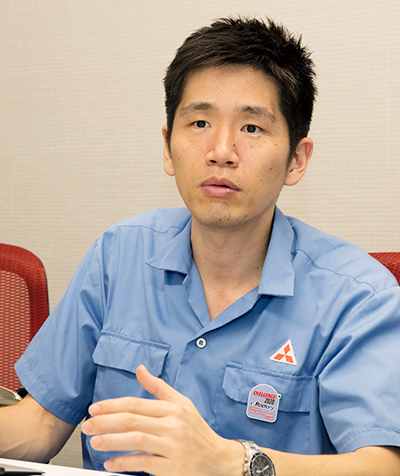
Hideki Takeuchi, Transformer Section, Sales Department, Nagoya Works
Thanks to international targets like the UN’s Sustainable Development Goals (SDGs) and the Paris Agreement on Climate Change, setting and attaining environmental standards is now a major issue for companies and organizations. Transformers are classed as “specified equipment” under Japan’s Energy Conservation Law, meaning that they are seen as devices that can contribute to higher energy efficiency. After new “Second Top Runner” criteria were set in 2014, customers are looking more carefully at the environmental performance of transformers. The EX-α exceeds the energy saving standards set out in the Second Top Runner criteria with an attainment rate of around 140% - with the potential to achieve even higher efficiencies.
“There is growing interest in environmental issues, so I think high efficiency transformers have massive appeal. Mitsubishi Electric offers two types of super high efficiency transformers: the EX-α and EX-β series. The EX-α, with an amorphous iron core, is ideal for customers wishing to reduce standby power consumption, like schools, research facilities and government offices, which use almost no power at night. The Ex-β, with a high performance electromagnetic steel strip, is well suited for factories which use electricity day and night and have a high load factor,” explains Takeuchi.

Mitsubishi Electric’s super high efficiency oil-immersed transformers achieve energy saving criteria of approximately 150% for the EX-α series and 120% for the EX-β series. Each model has a different maximum efficiency point (marked ★ above), allowing customers to select the optimum transformer for their installation environment and operating conditions.
Takeuchi recognizes that operators appreciate Mitsubishi Electric’s high quality standards as well as the excellent environmental performance of the equipment. The company’s focus on this aspect aligns with the demands of its customers. “We must not lose sight of quality. That was our top priority when developing the EX-α,” Takeuchi explains. Having verified the performance of the equipment in one of the company’s own buildings provides product quality assurance. “Most customers use the same transformers for several decades. The EX-α is a product we can recommend to them with total confidence,” concludes Takeuchi.
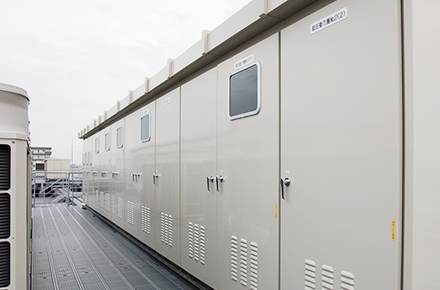
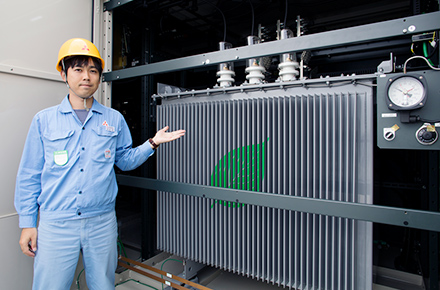
10 transformers installed in enclosures on the roof of the E1 Building (three-phase 750kVA x 3, three-phase 500kVA x 1, single-phase 300kVA x 4, single-phase 200kVA x 1) (Right: Transformer inside an enclosure)

